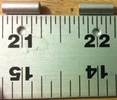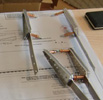


random user submitted photo
Enlarging the Cowling cut-out to improve CHT cooling.
22 posts
• Page 3 of 3 • 1, 2, 3
Re: Enlarging the Cowling cut-out to improve CHT cooling.
XenosN42 wrote:Hi Peter,
It appears that you've misread the graph showing my cylinder head temperatures. The lowest is the cylinder #2. Your #2 cylinder is also the coolest. Here is a larger image of the graph.
When I look at the graphs from my flights (and I do save the data my EFIS stores from every flight) I'm more concerned with changes than absolute numbers. The raw numbers could be due to installation errors, a slightly bad CHT cable, errors in the EFIS, etc.
Now let's say that the temperature line for the #2 cylinder starts to match the other cylinders. One might say "it's still well below the maximum allowed CHT so no problem". However, the change indicates that something may be wrong and that should be investigated.
Regarding your high CHT on climb out you may want to consider testing to see if the temperature of #3 is really as high as your instrument is measuring. Harbour Freight has some inexpensive infrared thermometers that will suffice. Just fly around awhile, land, quickly take off the cowling and see if your EFIS numbers match the thermometer.
Also make sure that your mixture is rich enough during climb. Lean engines run hotter.
Good luck. At least you didn't experience what one local builder(?) and pilot(?) did on his first and only flight. ( Don't worry he walked away, but his Sonex didn't fair so well. ) Turns out that soon after take off at about 500 feet his cylinder temps were hitting 500. He quickly completed the pattern and managed to stall about 50 feet above the ground. After the first bounce the plane wing landed on a runway light which cleanly cut thru the bottom and top skins.
So why were his temps so high? A few days before that flight I was showing a few local pilots this guys Sonex, and comparing it to my XENOS. When I looked at his AeroVee I noticed that the super tin was installed on the TOP of the cylinders. So I asked him "Is this installed correctly?" He said "I think so". I pulled out my manual and pointed out the page that describes how to install the super tin. I then said "It will only take you about 2-3 hours to install it correctly. Not much time considering you spent 10 years building the plane. But if you don't do that at least take it off. It's doing more harm than good on the top".
Well guess who decided not to invest that 2-3 hours?
-- Michael
Yesterday we went for another flight and did some touch and go's, the day before I did 3 slight alterations: 1: adjusted the electronic Ignition about 2 a 3 degrees less advanced. 2: Filed the upper lip of the RHS (passenser side) cooling inlet smooth to improve laminar flow. 3: Removed cylinder head casting debris in the gap between the 2 cylinders on both sides and filed it a bit smoother.
During yesterday flight we were impressed with the CHT improvement. We were able to climb from ground level (100' above sea level) directly to 2000' while #3 CHT stay around 400F. We were on MTOW climbing at IAS 75 to 80M/hr doing about 400 to 500 fl/min. OAT was 65F.
During cruising switching off the electronic ignition the engine dropped about 20RPM. Switching off the magnetos during the cruise the engine RPM also dropped with about 20RPM. For me this indicate that both ignitions are firing together and the electronic ignition is set correctly. I did not see much change in CHT during this test. It looks like I am on the right track. The weather is also a bit cooler now and I think I can get the CHT even a bit lower. Thank you all for your advise.
Peter
- bakfly
- Posts: 40
- Joined: Fri Aug 03, 2012 5:30 am
Re: Enlarging the Cowling cut-out to improve CHT cooling.
XenosN42 wrote:....When I looked at his AeroVee I noticed that the super tin was installed on the TOP of the cylinders. So I asked him "Is this installed correctly?" He said "I think so". I pulled out my manual and pointed out the page that describes how to install the super tin....
This is the THIRD occurrence that I know of, where someone installed the Super Tins on the top of the engine. I can't for the life of me figure out how these builders can possibly think this is correct. I mean, just logical thinking about how the air needs to move through the cowl should be enough. But ignoring that the manual is pretty clear, with both text and a photo. It says: "Install the super tin under the cylinders and cylinder head. It "snaps" in place with the dividing rib between the cylinders and the cylinder head. See photo at right." And the photo caption says: "The super tin is installed under the cylinders and cylinder heads. Friction keeps it in place." The photo clearly shows the Super Tin UNDER the cylinder, not on top. What part of UNDER is hard to understand??? I just don't get it.
Oh well....
Joe Norris
Sonex N208GD (S/N 450)
Sonerai II N13NN (S/N 1206)
Fortes Fortuna Adiuvat
Sonex N208GD (S/N 450)
Sonerai II N13NN (S/N 1206)
Fortes Fortuna Adiuvat
-

Sonerai13 - Posts: 413
- Joined: Tue Nov 05, 2013 5:36 pm
- Location: Oshkosh, WI
22 posts
• Page 3 of 3 • 1, 2, 3
Who is online
Users browsing this forum: No registered users and 110 guests








